
As a Business Owner or Design Director, Here’s Why Graphic Design Retainers Are Your Solution. In the world of business and branding, certain aspects demand your attention—whether it’s presenting clients with a thoughtful vision board idea or simply choosing the right color palette. However, if you’re an entrepreneur or a design director, you likely face more significant challenges. This is where outsourcing graphic designers can become a crucial but potentially hectic task.
Designing is a common aspect for businesses to outsource because translating visionary imaginations into reality is no ordinary skill. While deciding on a font logo, social media graphics, or creating a new brochure template may seem straightforward, graphic creators are trained professionals who excel at such tasks. Every emerging brand needs a well-suited graphic artist to bring your branding ideas to life and elevate the appeal of your marketing visuals. Having a designer available around the clock is as essential as your morning coffee to get through the day. Working with a designer on a retainer can significantly boost your business.
In this article, we’ll explore everything about graphic design retainers and how you can make the most out of this invaluable resource.
What is a Graphic Design Retainer, and How Does it Work?
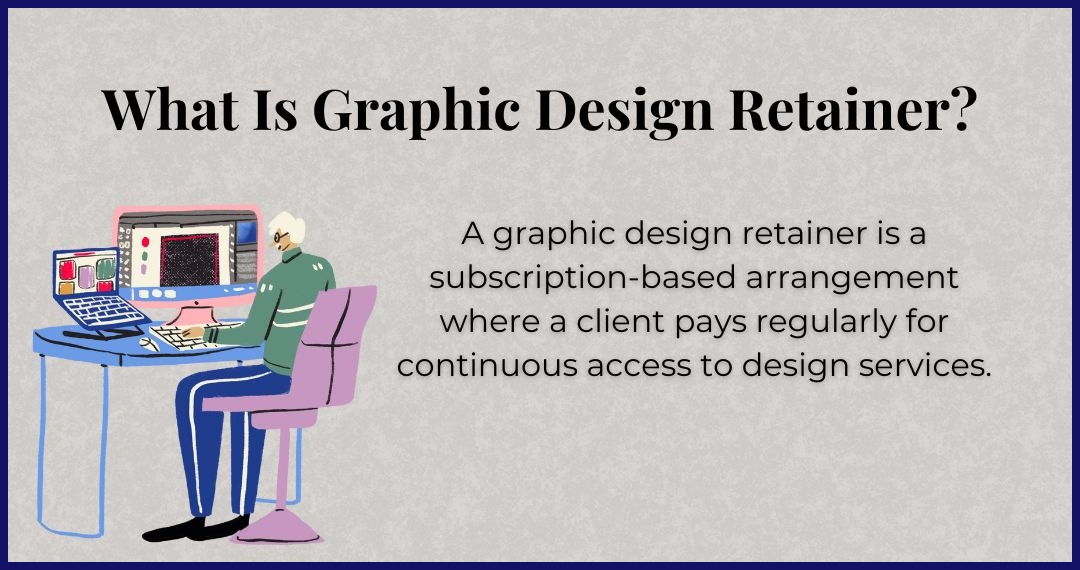
If you don’t know how retainers work between the graphic artist and the person hiring the designer, I’m here to help.
A retainer is an arrangement where a client secures the services of a graphic artist on an ongoing basis, typically through a monthly fee.
A retainer is an established contract between a designer and the client—a sort of arrangement where, for example, you could dedicate 20 hours or more hours each week to your client for a monthly retainer rate. During these 20 hours, the designer might be needed on call at any moment, or not.
With the retainer agreement, the designer still gets paid even if the client doesn’t have work for them. As part of the contract, the designer has to ensure they are readily available for the client for the full 20 hours. If you’re a freelance designer, you might have to ensure you schedule your time for multiple retainer clients without conflicting with other design projects.
Benefits of Working on Retainers
Designers POV:
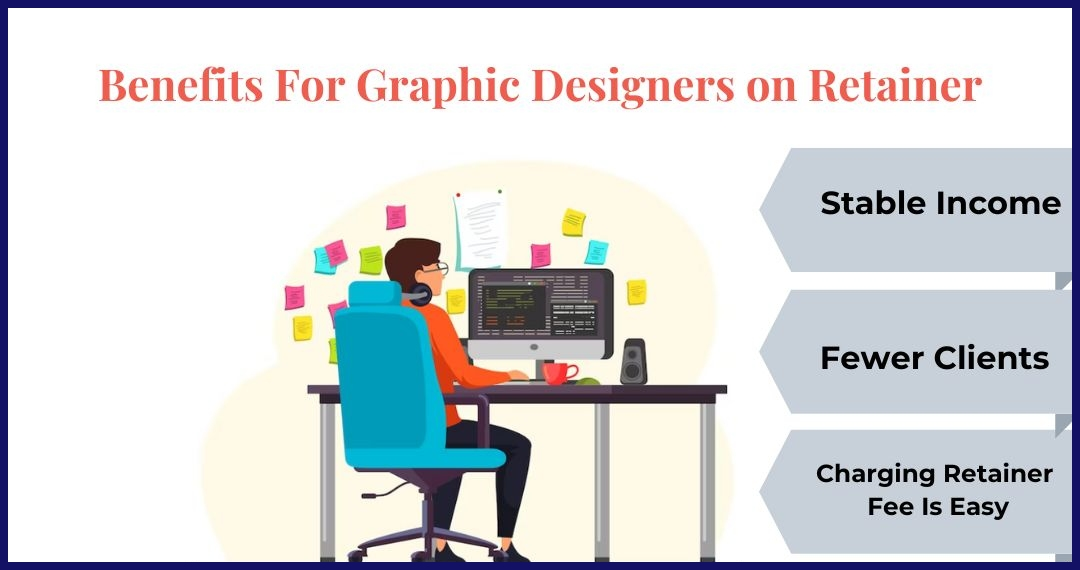
For an actual professional designer, having a retainer contract is the dream. A designer retainer lets you work with an established business or brand for an extended period. Here are some of the biggest benefits of working on a retainer.
Stable Income
Even if you are into freelancing, income can be a bit unpredictable. However, being part of retainers gives you a more predictable income and actually provides a great work-life balance. If you can quickly add multiple clients at a monthly retainer fee for each client, it helps you secure a stable source of income.
Fewer Clients
The major challenge for a freelance graphic artist is the need to find new clients to maintain a steady income constantly. This process can be tedious, especially when it involves learning about new clients frequently. Seeking out retainer work can significantly benefit graphic creators. You can work with a handful of clients on an ongoing basis through a mutual contract.
A few long-term client projects are enough for your job security and are much easier to handle than managing short-term clients. It can reduce your stress and provide a better understanding of other client projects and their goals and objectives, making you feel more like you’re part of the team.
Charging Clients is Easy
While being a freelancer, you might experience confusion about what to charge for your client’s projects. Depending on the size of the business, project scope, and other notable factors, you’ll have to deal with fluctuating design rates. However, while being on a retainer contract, you can ask new clients for flat design fees, making it much easier to handle your finances.
Brands POV:
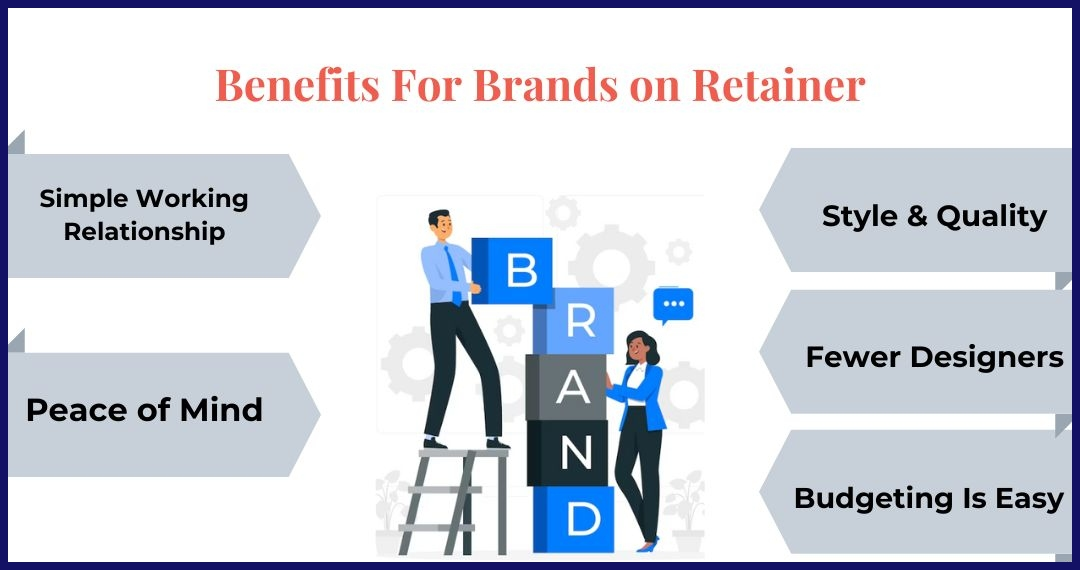
Simple Working Relationship
As a business working with a designer for the first time, you might need to familiarize yourself with their vision, style, and the personality of your brand. There’s also a chance that they won’t get it right the first time around and may need to work on a bunch of revisions to get the design spot-on.
If you’re working with many graphic artists on various design initiatives, then you have to go through this process over and over again. So, it’s highly preferred to work with a designer on more than one project. As a manager or a brand, you’ll be in the groove of working together, enabling two-way communication where you can easily provide feedback, and they can contribute their creative thoughts effortlessly.
Consistent Style and Quality
When working with multiple freelancers, each designer has their own style and way of working. If your brand has a specific style, and if all the designers come up with different styles, it can cause turbulence in the brand identity. Having a good and consistent brand designer can make a significant difference. When you regularly work with the same designer, the style and quality of the design will be consistent across all your branding, including social media graphics, logo design, and more.
Rather than getting a mishmash of designs from various designers, you can actually create a memorable brand identity with a graphic artist retainer.
Budgeting is Easy
As a business or an agency, budgeting, bookkeeping, and accounting can be boring and a hassle. With the fluctuating design fees, you’re paying to multiple designers, having a designer on retainer can simplify your budgeting. You pay a fixed amount each month, quarter, or year. Unlike other projects, which can be confusing, you’ll be paying a fixed amount, helping you stay organized and plan your budget effectively.
Less Paperwork
Having a designer on retainer means you have less paperwork to deal with. As a brand or business, you don’t have to worry about being organized. When you have a multitude of designers, freelancers, or other associates, each comes with quotes, invoices, and so on. That’s an awful lot of documents to keep track of. But with a retainer contract, you only have to spend less time doing paperwork.
Peace of Mind
One of the main benefits of having a designer on retainer is having your own peace of mind. You can focus on other important aspects of your business on unused hours while an expert handles the designing part. You don’t have to worry about the schedule because the designer will meet the deadlines, and your project will be completed on time.
Types of Graphic Design Retainer Contracts
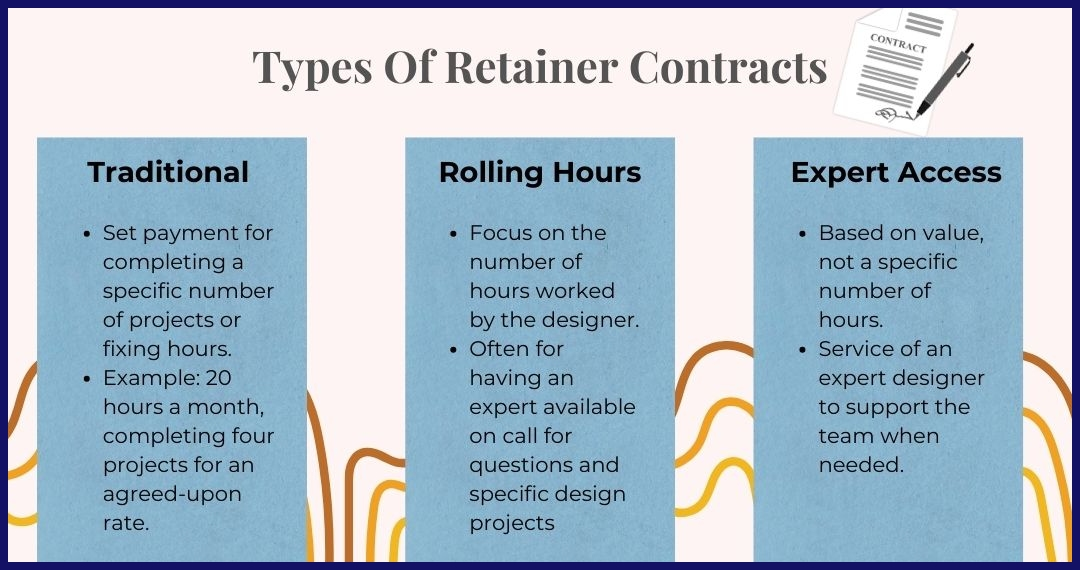
There are several types of retainer contracts where you can negotiate with the client depending on your expectations and the support they require. Here are a few types of retainer contracts you can start with:
Traditional Retainer: This type of retainer involves a set payment to work, either by completing a certain number of projects or by fixing a set number of hours to work. For example, 20 hours a month and completing four projects per month for an agreed-upon rate sums up the traditional retainer.
Rolling Hours: Some retainer agreements are focused on the number of hours worked by the designer. This arrangement is often for having an expert available on call to answer questions and work on certain design projects when support is needed.
Access to an Expert: Other retainer contracts are based on value and not the specific number of hours worked. This is for the service of an expert designer to support the team when required.
Retainer Agreement: What to Include?
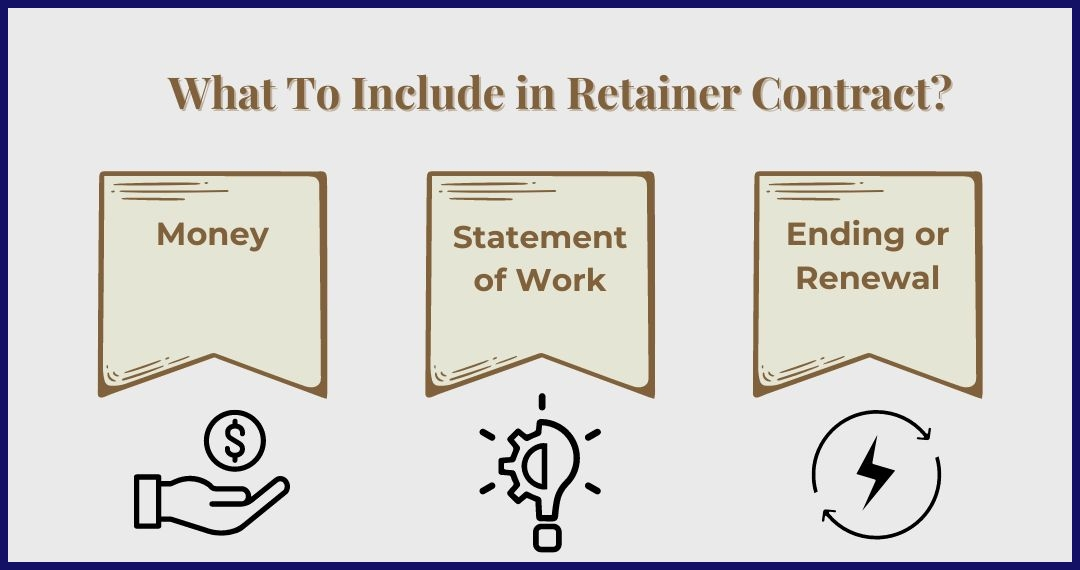
A retainer agreement should be structured differently compared to a freelancing contract. You need to establish terms for elements that are specific to a retainer package. Here are the important elements to be included in the contract below:
Money
The most important element of the agreement should be the amount of money on which both the designer and client have agreed. Make sure to include any other expenses related to the design project and other possible reimbursements.
Statement of Work and Services
Outline the exact service the designer is offering or performing. If the retainer contract is based on hourly performance, be clear on the type of graphic design services being offered. If the retainer is just for a particular task, outline it in more detail so it has correct details about the statement of work.
Ending or Renewing
As a designer, if you’re considering an end to the contract, it gives you an opportunity to renegotiate your rates in the future. Mention the notice period both parties are planning to use when ending the contract. Normally, thirty days is considered the standard amount, giving the client and the designer time to replace the work.
Graphic Design Retainer Fee
As a designer, you might be confused about the amount to be charged per project or month. The retainer package depends on the scope of work you’re doing and the client’s creative project. As an experienced designer, you can start by charging between $700-$3000/month based on proven results from past projects. Developing technical skills and creating a top portfolio can support and help you access higher fees.
How do You Write a Graphic Design Retainer Contract?
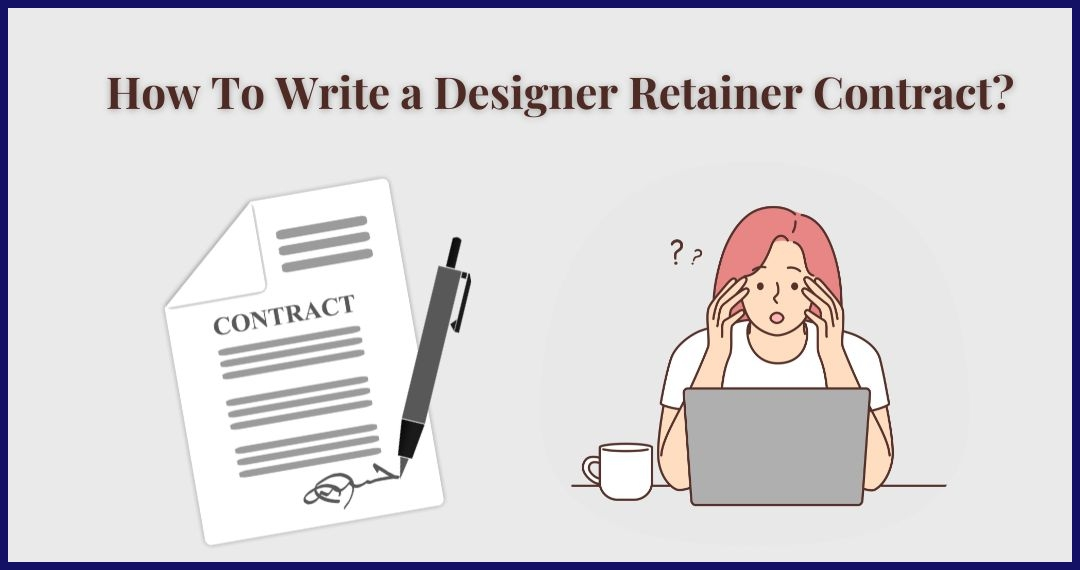
A retainer agreement is necessary for both the brand and the designer, and now you know the important elements to outline the official contract. Here’s how you can take what you learned above and put it all together.
Discover the Retainer Graphic Designer Needs
Communicate with the responsible designer through a call and understand how they are working with other retainer clients. Check their existing retainer agreements so that you’ll know what to expect from them. Either way, you can establish the retainer agreement for things like sending payments, confidentiality agreements, executing projects, and terminating the contract.
Highlight Your Goals and Objectives
Let the designer clearly understand your goals and objectives from maintaining a retainer with them. State the expectations and importance of the projects, communicate the brand identity with the designer, and remind them that you are trusting them for their design services. Talk about your product and service, aligning the ideals with the talent of the designer.
Call to Action
At this point, you still haven’t got the retainer security with the designer. If you’re still waiting for the designer’s signature, it’s important to provide a call to action that lets the designer know what step they need to take next. If everything in the contract looks good, respectfully ask them to let you know if there are other things they need to discuss and point them to sign the retainer contract.
Wrapping Up
A graphic designer retainer agreement is one of the easiest ways to get design work done on time and with perfection. With the designer’s expertise, brands don’t need to worry too much about paperwork, deadlines, or other issues; a graphic creator on retainer can assist with any design needs. The work begins once the retainer agreement has been executed from both ends! It’s important to have a mutual understanding and showcase value as a designer and brand to bring out the best service from both ends to get near-instant gratification.
Well, we hope this article helped you decide if a retainer is right for you or not. Once you give this retainer contract a chance for a small task that needs to be done regularly, and if you’re comfortable with the work, you can increase the package and renew the agreement for more work. Some designers offer you a discounted rate when you sign up for a retainer package. So, it can actually save you time and money.
FAQ
1. How much should a graphic designer charge for a retainer?
Retainers for graphic design prices generally cost around $750-200 each month, depending upon the size of the design services. An experienced graphic artist can actually have a higher retainer rate in the agreement depending upon the hours they spend per month on the work
2. What is a retainer fee for an artist?
Graphic artists in retainer are paid in advance. A deposit will be paid before the service from the designer is completed. You pay the designer upfront, and then they’ll complete the project during the month. If the designer’s client couldn’t complete the payment, the work might get pushed to be finished on another date.
